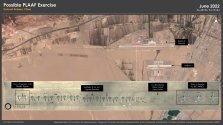plawolf
Lieutenant General
So I was racking my head for a bit wondering why this phrase sounded so familiar.
Then I remembered I heard almost the exact phrase from a F-35 test pilot (former RCAF F-18 pilot and with 5000+ hours of hours on F-18, F-15, Typhoon and all three F-35 variants) talking about the F-35 and the differences that new pilots training to start with the F-35 will have.
The specific part of this podcast is at 1 hr 5 minutes, but I highly recommend everyone have a listen to the whole episode because it talks about the F-35 as a whole, and really helps to demolish some of the popular misconceptions about the aircraft (misconceptions of which even some people on this forum still hold) -- but more importantly the discussions about the 5th generation experience is one that is very relevant to J-20 as well.
Overall, the F-35 is a very easy aircraft to fly, but is conveyed as an aircraft with significant potential that is difficult to fully exploit.
At 1 hr and 5 minutes, the pilot Lt Col Flynn discusses how the F-35's sheer capability in terms of sensor fusion, situational awareness, and stealth, means that pilots being trained for the F-35 now are all meant to be "independent decision makers" and to "think autonomously" more so than ever before.
That sounds a little bit simplistic, but he raises the example how in a four ship flight of legacy generation aircraft, are trained in two ship sections with a lead and a wingman, where the wingman largely follows the flight lead with less responsibility and authority than the lead.
With F-35s, every pilot in an entire four ship flight are tacticians themselves, with more autonomy and responsibility than ever before. The difference in sensors, datalinking, stealth and situational awareness overall means that unlocking the true potential of the aircraft doesn't require a pilot to only fly and fight, but to fly and fight and actively plan at the same time.
That all sounds very similar to what Chen Liu is saying, doesn't it?
Essentially -- 5th generation fighter are very easy to fight and fly in.... but to exploit the true, full potential that 5th generation fighters offer compare to legacy fighters, it requires pilots and pilot training to become more autonomous, able to carry out more complex decision making and interface with more friendly forces than every before.
To paraphase Siege's post, I think the best interpretation of the pilot's words is: "5th gen aircraft/J-20 is very easy to operate, but difficult to exploit its true, full potential" -- and that is solvable by pilot training designed from the outset to have them take advantage of 5th generation capabilities.
To clarify, I believe that a 5th generation fighter flown "to partial potential" will still be able to roflstomp legacy 4th, 4.5th generation fighters flown by the best pilots when circumstances are equal (or even in circumstances unfavourable to the 5th gen aircraft).
However, a 5th generation fighter flown "to full potential" will be able to exert even more laughably superior kill ratios against legacy aircraft than they already demonstrate.
Overall, I think people significantly underestimate the advances of superior situational awareness and superior stealth offers to warfighting capabilities, especially in the air to air domain.
If anyone has ever played a real time strategy game, it is the equivalent of having the benefit of the fog of war turned off for yourself and playing on a big screen LED monitor while your opponent is playing the same game with fog of war turned on, playing on a early 2000s CRT.
Your opponent would be busy just trying to scout, see where everything is, on an interface that conveys information poorly, unable to see beyond immediate line of sight, where they are fighting the game as much as fighting you.
But you on the other hand, have the eye of god and are able to produce exactly what you need, to position your units exactly where you want and time your moves and attacks exactly how you wish.
It is that sort of informational advantage that allows 5th generation fighters to achieve those sort of crazy kill ratios against legacy aircraft.
Not to drag this off topic, but a pretty important detail worth highlighting is that Col Flynn is on LockMart’s payroll and has been part of the F35 programme for quite some time and is clearly deeply invested in the success of the F35 on a very personal level, as you can easily tell from just that interview.
Understandable, but I cannot help but feel he goes into F35 salesman mode at times, which makes me hesitant to take everything he says at face value. But this isn’t about the F35.
Another thing with noting is that it’s pointless to compare 5th gens against legacy when the J20 was designed to face off against opfor 5th gens from the get-go. As such, to continue with your analogy, both sides now have fog of war turned off, in which case it’s not so overwhelming an advantage anymore.
On top of that ASEA advancements have also stripped back a lot of the inherent VLO advantages of 5th gens as evidenced by the recent reports on J20s being vectored in by KJ200s to F35s.
In addition, we see VLO UCAVs are also imminently coming into the mix, which further evolves the equation, and is a change the J20 is actively embracing with the new twin seater version.
All of this is not just to rag on the F35, but to point out and build upon an important training and doctrine distinction that Col Flynn raised himself during the interview.
Flynn stressed that he is a ‘4th gen baby’, and ‘doesn’t belong in an F35’, meaning all of his training and experience on 4th gens has developed habits and set patterns of thinking that inhibits his ability to fully embrace all the new technologies and capabilities that the F35 offers to fully exploit them. While I think he is being overly humble, it does seem to a consideration echoed by the PLAAF’s own experience as many, if not most of the J20 pilots are very young.
Perhaps the experience of jumping from J7s and J8s to J10s and J11s had given the PLAAF a good preview of how hard it could be for pilots to make such a huge capability leap and paradigm shift in air combat, so they are trying to not have to go through that again on the J20.
There may also be a similar, but maybe no less jarring training and doctrine shift in store for ‘5th gen baby’ pilots who started their flying careers on 5th gens, but have only trained against legacy. It could be similar to someone who got used to playing with god eye view suddenly finding fog of war enabled.


